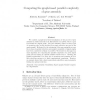Free Online Productivity Tools
i2Speak
i2Symbol
i2OCR
iTex2Img
iWeb2Print
iWeb2Shot
i2Type
iPdf2Split
iPdf2Merge
i2Bopomofo
i2Arabic
i2Style
i2Image
i2PDF
iLatex2Rtf
Sci2ools
TCS
2010
2010
Computing the graph-based parallel complexity of gene assembly
We consider a graph-theoretical formalization of the process of gene assembly in ciliates introduced in Ehrenfeucht et al (2003), where a gene is modeled as a signed graph. The gene assembly, based on three types of operations only, is then modeled as a graph reduction process (to the empty graph). Motivated by the robustness of the gene assembly process, the notions of parallel reduction and parallel complexity of signed graphs have been considered in Harju et al (2006). We describe in this paper an exact algorithm for computing the parallel complexity of a given signed graph and for finding an optimal parallel reduction for it. Checking the parallel applicability of a given set of operations and scanning all possible selections amount to a high computational complexity. However, an example shows that a faster approximate algorithm cannot guarantee finding the optimal reduction.
| Added | 30 Jan 2011 |
| Updated | 30 Jan 2011 |
| Type | Journal |
| Year | 2010 |
| Where | TCS |
| Authors | Artiom Alhazov, Chang Li, Ion Petre |
Comments (0)

